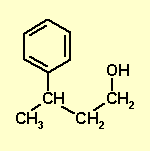|
Chemical shift implies HOCH2- The coupling of this CH2 requires that it be HOCH2CH2- Therefore the Ph and this HOCH2CH2 group are attached to the CH3CH group |

|
The following data is available from the
question.
Note
: Remember to cross
reference things to confirm.... e.g.
IR may show C=C, use NMR to
confirm that etc.
MS: M+ seen at 150 g/mol (no Cl or Br isotope patterns - they require m and m+2 of 3:1 or 1:1 respectively).
IR: There is no C=O near about 1700 cm-1 but there is an -OH (3350 cm-1). Absorbance near 1600cm-1 suggests C=C possibly aromatic.
13C nmr:
The proton decoupled spectrum shows a total of 8 peaks indicating 8 types of
C. By analysis of the chemical shifts, we have types in the region of C=C at
125-150ppm (probably ArC, 4 types), 1 peak near 70 ppm (possibly a C with
an electronegative oxygen attached) and then 3 peaks between 0-40 ppm that are
most likely from a hydrocarbon portion.
1H nmr:
The proton spectrum shows a total of 6 peaks indicating 6types of C. The peak
at 3.5ppm is a CH2, possibly with an electronegative oxygen attached. Then peak
at about 2.9ppm is a CH between 0-40 ppm that are most likely from a hydrocarbon
portion.
|
|
|
|
|
|
|
m |
5 |
5 Ar-H , monosubstituted aromatic. |
| 3.5 |
t |
3 |
CH2 coupled to 2H, deshielded (by O ?) |
| 2.9 |
t |
1 |
CH coupled to 2H, slightly deshielded |
| 2.4 |
s (brd) |
1 |
-OH |
| 1.7 | q | 2 | CH2 coupled to 3H |
| 1.2 |
d |
3 |
CH3 coupled to H |
(m
= multiplet, p = pentet, t = triplet, d = doublet, s = singlet)
The most significant structural information
from this is :
|
Chemical shift implies HOCH2- The coupling of this CH2 requires that it be HOCH2CH2- Therefore the Ph and this HOCH2CH2 group are attached to the CH3CH group |

|
The final step should always be to check what you
have drawn. The easiest thing to check is usually the coupling patterns you
would expect to see, and the chemical shifts of each unit. You should
be asking yourself : "Does my answer give me what the H-nmr shows ?"